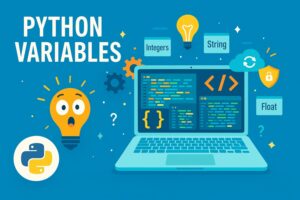Introduction: History of C++
Along the way, moments during the history of the C++ programming language transformed the way its developers think. There was a landmark event with the release of Stroustrup’s book in 1985. C++ was suddenly opened to the wider world. The 1998 ISO standard gave C++ world recognition and ensured that programmers from Tokyo to Toronto spoke the same “C++” language.
C++11 was another turning point because the new modern additions, including features such as lambdas and smart pointers, showed the language was by no means imprisoned in history but rather forward-propelled to meet the requirements of present-day programming. The safety and developer experience enhancements in C++20 and C++23 have cemented the language as not just current, but essential.

Fun Facts from History of C++
Every serious language has some trivia that spices up its story. Did you know that Bjarne Stroustrup initially called his project “C with Classes” because he thought it would be only a minor improvement? Or that the “++” was chosen because it humorously meant “the next version of C”?
Even to dates, C++ remains today the language that backs some notable names—Google Chrome engine, Adobe Photoshop, and parts of Amazon’s platform, all of which have reliance on it. In competitive programming contests, C++ is preferred due to the combination of its speed and flexibility which provides participants with an edge that is thinly sharp.
A Brief History of C++ – Real Life Application
The strength of C++ is its versatility. C++ operates on Windows operating systems and in gaming engines, like Unreal, and drives high-frequency trading algorithms in financial markets. Embedded systems in military-grade automobiles, IoT devices, and space exploration have all relied on C++ for its versatility, reliability, and efficiency.
This shows that A Brief History of C++ is not a closed chapter but an ongoing journey. The language is still at the core of innovation across industries.
History of C++: The Road Ahead
C++ programming language tells us one thing when we look out into the future: its adaptability is its superpower. With every standard, C++ metamorphoses to fulfill requirements of modernity-safety in code, easiness in syntax, and library advancements for AI, robotics, big data, and so on.
Already, C++23 has introduced features that aid coding, and the debates for C++26 are well underway. This constant change is why C++ will not fade away even as newer languages are emerging in front-liners like Rust or Go.

History of C++: a Coding Example.
While the Brief History of C++ actually makes clear how the language has transformed, practical coding only brings it to mastery. History of C++ talks about what C++, but code does the job of showing how it works. This is the reason why we have provided twenty well-deliberated C programs arranged from the beginner to the advanced level. .
These examples will boost your confidence in developing problem-solving skills, while practitioners could use this to revisit the ground principles. In integrating the theoretical knowledge about the History of C++ programming language into practical coding-the execution will always be amplified by the theory.
15 C Programs from Beginner to Advanced: History of C++
After learning about History of C++, practice compounds skill. Start simple, then stack ideas: input/output, loops, arrays, functions, data structures, algorithms, and finally concurrency. Each program below is self-contained and ready to compile with gcc.
1) Hello World in C
The classic first step. It checks that your compiler, environment, and I/O are working. If this compiles and runs, your toolchain is alive and kicking.
#include <stdio.h>
int main(void) {
printf(“Hello, World!\n”);
return 0;
}
2) Add Two Numbers
Reading input is foundational. This program accepts two integers and prints their sum. Try different inputs and watch standard input/output in action.
#include <stdio.h>
int main(void) {
int a, b;
printf(“Enter two integers: “);
if (scanf(“%d %d”, &a, &b) != 2) {
printf(“Invalid input.\n”);
return 1;
}
printf(“Sum = %d\n”, a + b);
return 0;
}
3) Even or Odd
Branching is how programs make decisions. Here we use the modulo operator to classify a number. Zero counts as even, by definition.
#include <stdio.h>
int main(void) {
int n;
printf(“Enter an integer: “);
if (scanf(“%d”, &n) != 1) return 1;
if (n % 2 == 0) printf(“%d is Even\n”, n);
else printf(“%d is Odd\n”, n);
return 0;
}
4) Factorial (Iterative)
Loops do repetitive work. Factorial grows fast, and it’s a neat way to flex a for loop. For large n, long long still overflows; we’ll keep it small for now.
#include <stdio.h>
int main(void) {
int n;
printf(“Enter n (0-20): “);
if (scanf(“%d”, &n) != 1 || n < 0 || n > 20) {
printf(“Use 0..20 for 64-bit safety.\n”);
return 1;
}
unsigned long long fact = 1;
for (int i = 1; i <= n; ++i) fact *= i;
printf(“Factorial(%d) = %llu\n”, n, fact);
return 0;
}
5) Swap Two Numbers (Without Temp)
A tiny arithmetic trick swaps values without a temporary variable. It’s cute, but in real code, a temp variable is clearer and avoids overflow.
#include <stdio.h>
int main(void) {
int a, b;
printf(“Enter a and b: “);
if (scanf(“%d %d”, &a, &b) != 2) return 1;
a = a ^ b;
b = a ^ b;
a = a ^ b;
printf(“After swap: a=%d, b=%d\n”, a, b);
return 0;
}
6) Prime Check (√n Optimization)
Primality tests are staple interview fare. Checking divisors up to √n is a big speedup over naïve division up to n.
#include <stdio.h>
#include <math.h>
#include <stdbool.h>
int main(void) {
int n;
printf(“Enter an integer > 1: “);
if (scanf(“%d”, &n) != 1) return 1;
if (n <= 1) { printf(“Not prime\n”); return 0; }
if (n <= 3) { printf(“Prime\n”); return 0; }
if (n % 2 == 0 || n % 3 == 0) { printf(“Not prime\n”); return 0; }
bool prime = true;
for (int i = 5; i * 1LL * i <= n; i += 6) {
if (n % i == 0 || n % (i + 2) == 0) { prime = false; break; }
}
printf(“%s\n”, prime ? “Prime” : “Not prime”);
return 0;
}

7) Fibonacci Series (Iterative)
This prints the first n Fibonacci numbers using constant space. It’s a solid exercise in loop state management.
#include <stdio.h>
int main(void) {
int n;
printf(“How many terms? “);
if (scanf(“%d”, &n) != 1 || n <= 0) return 1;
long long a = 0, b = 1;
for (int i = 1; i <= n; ++i) {
printf(“%lld”, a);
if (i < n) printf(” “);
long long next = a + b;
a = b; b = next;
}
printf(“\n”);
return 0;
}
8) Reverse an Integer
Working with digits builds comfort with integer arithmetic. This flips a number without converting to a string.
#include <stdio.h>
int main(void) {
long long n, rev = 0;
printf(“Enter an integer: “);
if (scanf(“%lld”, &n) != 1) return 1;
long long x = n;
while (x != 0) {
rev = rev * 10 + (x % 10);
x /= 10;
}
printf(“Reversed = %lld\n”, rev);
return 0;
}
9) Palindrome Number
A palindrome reads the same backward and forward. This reuses reversing logic and compares it to the original.
#include <stdio.h>
int main(void) {
long long n, rev = 0, x;
printf(“Enter an integer: “);
if (scanf(“%lld”, &n) != 1) return 1;
x = n;
while (x != 0) {
rev = rev * 10 + (x % 10);
x /= 10;
}
if (rev == n) printf(“Palindrome\n”);
else printf(“Not palindrome\n”);
return 0;
}
10) Armstrong (Narcissistic) Number
For d digits, an Armstrong number equals the sum of each digit raised to d. We compute digits, then the power-sum.
#include <stdio.h>
#include <math.h>
int main(void) {
long long n;
printf(“Enter an integer: “);
if (scanf(“%lld”, &n) != 1) return 1;
if (n < 0) { printf(“Not Armstrong\n”); return 0; }
long long tmp = n;
int d = 0;
if (tmp == 0) d = 1;
while (tmp != 0) { d++; tmp /= 10; }
tmp = n;
long long sum = 0;
while (tmp != 0) {
int digit = tmp % 10;
long long p = 1;
for (int i = 0; i < d; ++i) p *= digit;
sum += p;
tmp /= 10;
}
if (sum == n) printf(“Armstrong\n”);
else printf(“Not Armstrong\n”);
return 0;
}

11) Bubble Sort
Sorting is algorithm bread-and-butter. Bubble sort is simple but slow (O(n^2)). We do in-place swaps and exit early if already sorted.
#include <stdio.h>
#include <stdbool.h>
int main(void) {
int n;
printf(“Enter number of elements: “);
if (scanf(“%d”, &n) != 1 || n <= 0) return 1;
int a[1000];
if (n > 1000) { printf(“Max 1000 elements.\n”); return 1; }
for (int i = 0; i < n; ++i) scanf(“%d”, &a[i]);
for (int i = 0; i < n – 1; ++i) {
bool swapped = false;
for (int j = 0; j < n – 1 – i; ++j) {
if (a[j] > a[j + 1]) {
int t = a[j]; a[j] = a[j + 1]; a[j + 1] = t;
swapped = true;
}
}
if (!swapped) break;
}
printf(“Sorted: “);
for (int i = 0; i < n; ++i) printf(“%d%c”, a[i], i+1<n?’ ‘:’\n’);
return 0;
}
12) Binary Search (Iterative)
Searching a sorted array in O(log n) is a rite of passage. This version avoids recursion and returns the index or -1 if missing.
#include <stdio.h>
int main(void) {
int n, key;
printf(“Enter n: “);
if (scanf(“%d”, &n) != 1 || n <= 0) return 1;
int a[1000];
if (n > 1000) { printf(“Max 1000.\n”); return 1; }
printf(“Enter %d sorted integers: “, n);
for (int i = 0; i < n; ++i) scanf(“%d”, &a[i]);
printf(“Enter key: “);
scanf(“%d”, &key);
int lo = 0, hi = n – 1, ans = -1;
while (lo <= hi) {
int mid = lo + (hi – lo) / 2;
if (a[mid] == key) { ans = mid; break; }
else if (a[mid] < key) lo = mid + 1;
else hi = mid – 1;
}
if (ans == -1) printf(“Not found\n”);
else printf(“Found at index %d\n”, ans);
return 0;
}

13) Matrix Multiplication
Working with 2D arrays sharpens indexing skills. We multiply A (r1×c1) by B (r2×c2) if c1 == r2. The result is r1×c2.
#include <stdio.h>
int main(void) {
int r1, c1, r2, c2;
printf(“Enter r1 c1: “);
if (scanf(“%d %d”, &r1, &c1) != 2) return 1;
printf(“Enter r2 c2: “);
if (scanf(“%d %d”, &r2, &c2) != 2) return 1;
if (c1 != r2 || r1 <= 0 || c1 <= 0 || r2 <= 0 || c2 <= 0 || r1>50||c1>50||r2>50||c2>50) {
printf(“Incompatible or too large.\n”);
return 1;
}
int A[50][50], B[50][50], C[50][50] = {0};
printf(“Enter A (%dx%d):\n”, r1, c1);
for (int i = 0; i < r1; ++i)
for (int j = 0; j < c1; ++j) scanf(“%d”, &A[i][j]);
printf(“Enter B (%dx%d):\n”, r2, c2);
for (int i = 0; i < r2; ++i)
for (int j = 0; j < c2; ++j) scanf(“%d”, &B[i][j]);
for (int i = 0; i < r1; ++i)
for (int k = 0; k < c1; ++k)
for (int j = 0; j < c2; ++j)
C[i][j] += A[i][k] * B[k][j];
printf(“C = A*B:\n”);
for (int i = 0; i < r1; ++i) {
for (int j = 0; j < c2; ++j) printf(“%d “, C[i][j]);
printf(“\n”);
}
return 0;
}
14) File Handling (Write → Read)
Files are how programs remember things. We write a few lines to a file, then read them back and print them to the console.
#include <stdio.h>
#include <stdlib.h>
int main(void) {
const char *fname = “sample.txt”;
FILE *fp = fopen(fname, “w”);
if (!fp) { perror(“fopen”); return 1; }
fprintf(fp, “C file I/O demo\n”);
fprintf(fp, “Line two: persistence matters.\n”);
fclose(fp);
fp = fopen(fname, “r”);
if (!fp) { perror(“fopen”); return 1; }
char buf[256];
printf(“Contents of %s:\n”, fname);
while (fgets(buf, sizeof(buf), fp)) {
printf(“%s”, buf);
}
fclose(fp);
return 0;
}

15) Singly Linked List (Insert & Traverse)
Dynamic data structures are where pointers start to click. We insert at the head and traverse to print all values.
#include <stdio.h>
#include <stdlib.h>
typedef struct Node {
int data;
struct Node *next;
} Node;
Node* push_front(Node *head, int val) {
Node *n = (Node*)malloc(sizeof(Node));
if (!n) exit(1);
n->data = val;
n->next = head;
return n;
}
void print_list(Node *head) {
for (Node *p = head; p; p = p->next) {
printf(“%d%s”, p->data, p->next ? ” -> ” : “\n”);
}
}
void free_list(Node *head) {
while (head) {
Node *tmp = head->next;
free(head);
head = tmp;
}
}
int main(void) {
Node *head = NULL;
int n;
printf(“How many nodes? “);
if (scanf(“%d”, &n) != 1 || n < 0 || n > 100000) return 1;
for (int i = 0; i < n; ++i) {
int x; scanf(“%d”, &x);
head = push_front(head, x);
}
print_list(head);
free_list(head);
return 0;
}
Also Read:
- Variables in C++: Declaration, Initialization, Rules, and Reference Variables (2025 Variables)
- Proxy Pattern | C++ Design Patterns
- Understanding the C++ Array: An Effective 11 Step Guide
- The Effective Guide on Encapsulation in C++ with a Real-Life Example
Learn DSA with PW Skills C++
If you find A Brief History of C++ stimulating, why not advance into actually coding in it? The PW Skills DSA C++ course is meant to develop a solid programming foundation from scratch. And you will be able to understand all about the History of C++.
Hands-on work with problem-solving along with an organized roadmap will allow you to complement your theoretical learning with coding skills that will be appreciated by top companies. The course can be a springboard for you, whether you wish for internships or to crack product-based interviews.
It balances low-level memory manipulation (like C) with higher-level abstractions (like OOP) - a good midway between hardware and software. C++ is generally accepted to be faster since it compiles directly into machine code, while an interpreted language does not. From C++, OOP, templates, and efficient memory control have been invented, inspiring languages such as Java, C#, and even Rust. Learn from modern standards, i.e., C++11 or C++17, for they are well-supported, easy to learn, and relevant in the industry.FAQs
Why is C++ called a middle-level language?
Is C++ faster than Python and Java?
How has C++ influenced modern programming?
Which version of C++ should I start with?

